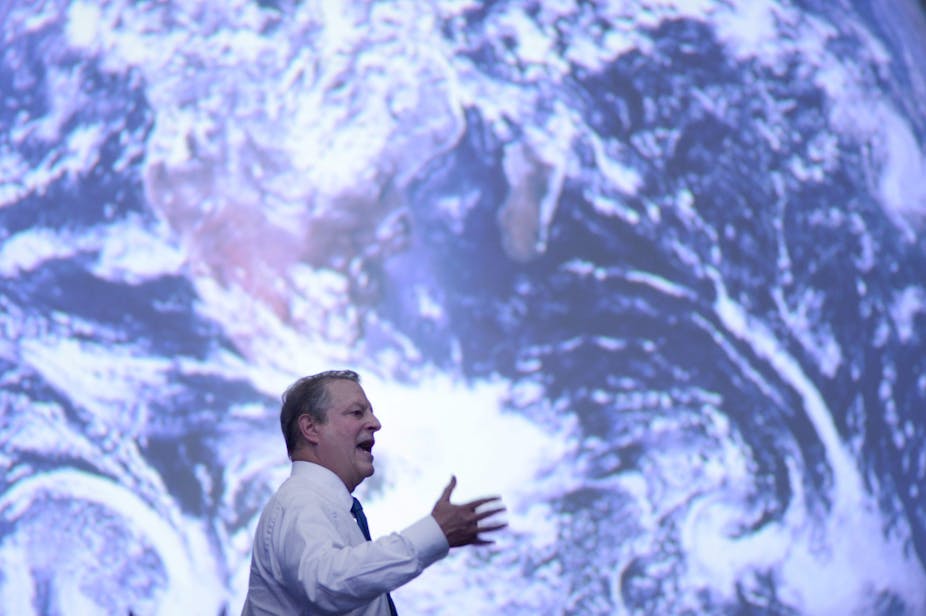Climate campaigner Al Gore has been in Australia again - but this time he didn’t share a stage with a beaming Clive Palmer. He didn’t go anywhere near Canberra. And he had good reason.
Gore, the former US vice-president who travels the world spruiking action on climate change, wanted to meet with state governments and city councils instead. He has jumped on an emerging trend: a broadening of responsibility for addressing climate change.
Under the United Nations system it is national governments that are supposed to make emissions pledges and enact policies. Some are doing so.
But the reality is it’s often provincial governments or city councils who are the most ambitious, especially where national governments leave a policy void.
From the ground up
A global patchwork of thousands of provinces and councils enacting separate climate policies may sound messy, and it’s very much Plan B for the UN Framework Convention on Climate Change. But this bottom-up mish-mash might just prove efficient at reducing greenhouse gas emissions - while some national politicians grandstand and dither on the sidelines.
Gore, a Nobel laureate who gave his trademark slideshow to 1,000 staff and students at the University of Melbourne on Monday, talked about states that are “moving” on climate change: California, Washington and Oregon in the United States, and Canada’s British Columbia.
“I have a feeling that some parts of Australia are thinking of moving,” he added in his breezy Tennessee accent. “I’m stoked about that.”
Earlier in the day Gore met with ministers from the Labor states of Victoria, Queensland and South Australia, plus senior public servants from New South Wales and the ACT.
Later he told the university event, organised by the Melbourne Sustainable Society Institute, that those state governments “understand this crisis and the nature of the opportunity” (such as renewable energy).
It’s a different approach to Gore’s memorable joint press conference with federal MP Clive Palmer in Parliament House a year ago. The pair announced that Palmer would vote to scrap the carbon price, while saving the furniture (the Renewable Energy Target, the Clean Energy Finance Corporation etc).
This time around, Gore didn’t target federal politicians - he could hardly show his slide of a Hawaiian wind farm surrounded by flowers to Prime Minister Tony Abbott, who finds them “ugly”. (Gore did have a quick lunch with Opposition Leader Bill Shorten.)
Instead, Gore looked to the states to ginger up Australians ahead of the major UN climate summit in Paris in December.
Top of his mind was California, the example he cited frequently on this trip. Former Republican Governor Arnold Schwarzenegger got an emissions trading scheme through state parliament and it started under the Democrats in 2012. (The design is fairly similar to Australia’s first emissions trading scheme under Kevin Rudd.)
Australian legislators might learn something from the video below, produced to counter an industry campaign to scrap the ETS.
California now has bills on the table to cut transport emissions and increase renewable energy, as well as a legislated emissions target. The Victorian government is particularly interested in the Californian example.
Gore also name-checked the Canadian province of British Columbia, which has had a carbon tax since 2008, introduced by the centre-Right Liberal Party. Petrol pumps in Vancouver now show the carbon tax ticking over.
British Columbia has relatively strict energy-efficiency regulations on buildings and their contents, a requirement that 93% of new electricity supply be renewable, and all government agencies offset emissions.
Gore didn’t mention Chinese provinces but there are seven state or city-based carbon trading schemes in China; the Beijing ETS covers everyone from Microsoft to news agency Xinhua.
The climate see-saw
So can Australian states follow suit? They already have. NSW had an ETS, which was scrapped in 2012 to avoid duplication with the (now defunct) federal carbon tax.
Victoria’s Labor government passed a bill in 2009 to cut emissions by 20% by 2020 and had a plan for the staged closure of the Hazelwood coal-fired power plant. The Liberals won government in 2010 and reversed those plans.
So there’s an Australian policy pattern best described as messy, regardless of one’s view on climate change. Sometimes the states act, sometimes the federal government does, but governments keep changing. Climate change has been caught in a federal-state see-saw which has left little policy intact.
That’s why Gore’s list of frontrunner states doesn’t include any Australian examples.
That’s also perhaps why no premiers met Gore on Monday. They face a tough choice - are they really ready to ramp up climate ambition, and cope with the risks of a hostile media campaign and a possible voter backlash?
Climate policy has helped see off three Australian prime ministers and two opposition leaders since 2007. The temptation to back away quietly is real.
South Australia and Queensland are talking up their climate ambition, while Victoria is formally reviewing its climate options, including an energy efficiency campaign, new emissions targets, and more renewable energy. (They’re all Labor states.)
Meanwhile, insiders are closely watching the Liberal NSW government, which is a different beast ideologically to the federal Abbott government. Watch to see if ministers from any state go to the UN Paris summit.
So it was perhaps the state premiers, and not the Melbourne University students present, that Gore had in mind when he called for “moral courage” on climate change, as he stood in front of a huge slide of the planet.

